Applying Boolean search techniques is your key to narrowing down your LinkedIn search successfully.
But what is boolean search exactly?
LinkedIn boolean search basics
LinkedIn Boolean search is a type of search thatallows users to combine keywords with operators such as the use of quotation marks, brackets, AND, OR, and NOT to produce more relevant results. These operators are the building blocks of any Boolean search, especially when navigating LinkedIn’s network.
Boolean operators
When looking for a job or the perfect candidate on LinkedIn, using boolean operators can greatly refine your search results.
Quotation marks for precise search LinkedIn boolean example
Using quotation marks in your LinkedIn Boolean search can dramatically narrow down your results to the most relevant profiles or jobs.
For instance, if you’re looking for a specific job title, placing quotation marks around “freelancer copywriter” ensures that the search engine only returns profiles or job listings with that exact phrase.
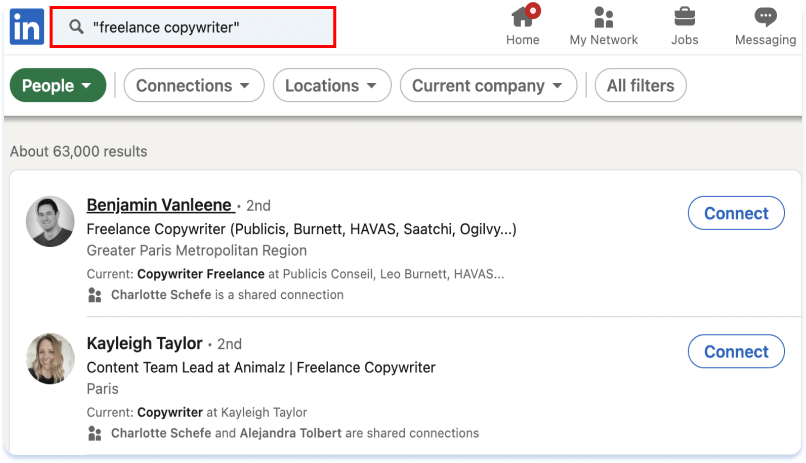
This eliminates any ambiguity and provides you with a more precise set of results.
Brackets to specify string applications
Much as in maths, with brackets you can specify closer what job titles you wish to include or exclude from your search.
In this example, we only want VPs, but we don’t wish to have either assitant or SVPs included in our search.
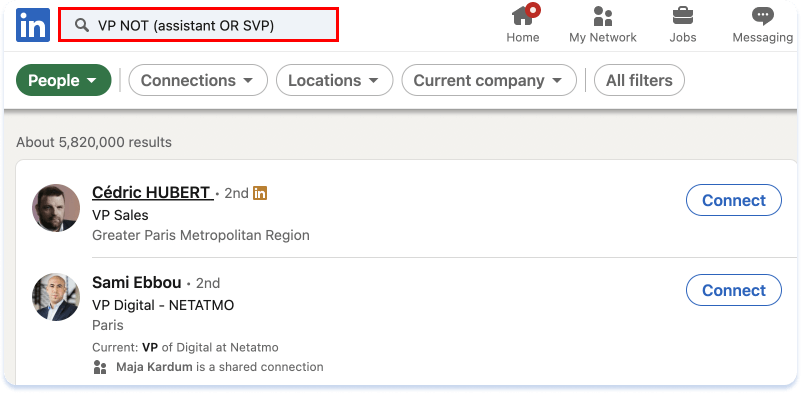
NOT operator to exclude specific profiles
The NOT operator is particularly useful when you want to exclude certain terms from your search.
For example, if you’re looking for seasoned professionals, you might want to exclude entries with “entry-level” or “associate”. A search query could look like this:
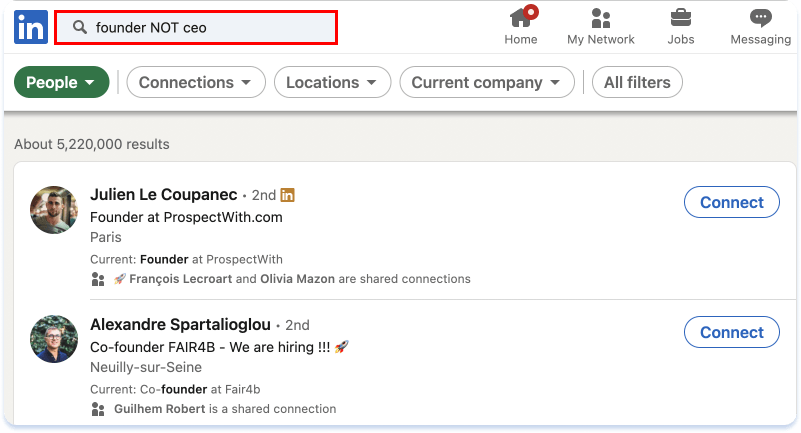
However, if you wish to eliminate more than one title, use parentheses, as so: project manager NOT (entry-level OR associate)
By excluding these terms, you refine your search to target more experienced candidates, thus making your search more efficient.
AND to list your searches
The operator AND will narrow your search, ensuring that only profiles containing all the specified terms are displayed.
This operator will allow you to make a list of all of the job titles, locations, etc. you wish to include in your search, avoiding having to conduct different searches.
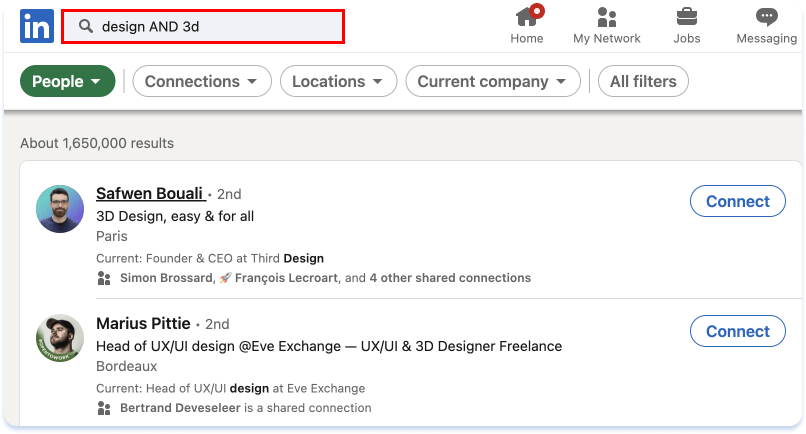
OR operator for a wide net search of job titles
Conversely, the OR operator is your go-to when you want to cast a wider net. This is particularly useful when job titles vary across industries or companies.
For instance, if you’re open to similar roles that might go by different names, you could use:
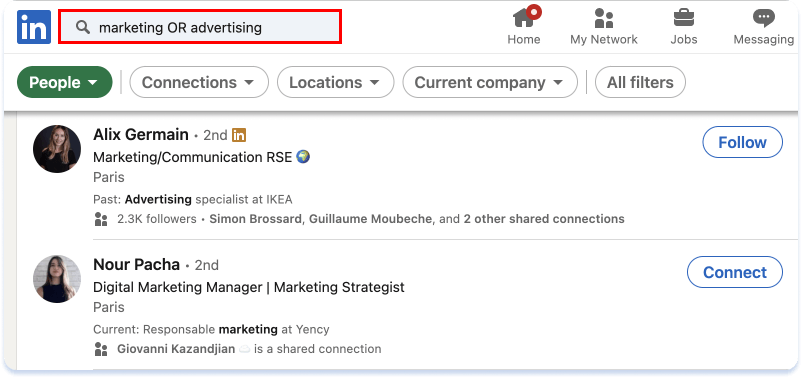
This search string ensures that you don’t miss out on potential candidates who may have the skills you need but hold a slightly different title.
With these advanced techniques, you can ensure that your LinkedIn Boolean search is not only effective but also incredibly specific to the types of profiles or jobs you’re aiming to find. The precision and flexibility of Boolean logic make it an indispensable tool for any professional looking to optimize their LinkedIn search strategy.
Advanced boolean search techniques on LinkedIn
The correct use of Boolean search techniques on LinkedIn can significantly enhance your ability to locate the right sales leads, marketing opportunities, or job candidates. By combining operators and understanding their hierarchy, you can construct powerful search strings that yield targeted results.
Build search strings with the strategic combo of operators
When using LinkedIn’s Sales Navigator, the strategic combination of Boolean operators can be a game-changer for lead generation.
Consider a real-world scenario where you’re seeking a content writer with expertise in technology.
- “content writer” AND technology NOT (junior OR intern)
This string uses quotation marks to specify an exact phrase, the AND operator to combine two key requirements, and the NOT operator paired with OR to exclude profiles with terms that might denote a level of experience not aligned with your needs.
- (“Vice President” OR “Director”) AND “Information Technology” NOT “Assistant”
This search string leverages the AND operator to ensure that profiles include high-level titles and the technology sector, while the NOT operator excludes assistant-level positions, thus honing in on your ideal prospects.
Search strings will ensure that you fin exactly what you’re looking for in just one search, excluding everything you do not want getting in the way.
Hierarchical ordering of operators and their impact on search results
The order in which you use Boolean operators affects the outcome of your search.
LinkedIn prioritizes the NOT operator first, followed by AND, and lastly OR.
This hierarchical ordering means that you should structure your search strings with precision. For instance:
(NOT “intern”) AND (“marketing manager” OR “brand strategist”)
In this example, the search will first exclude any profiles with “intern” before combining the remaining profiles that contain either “marketing manager” or “brand strategist”.
Common errors in Boolean searches
Common mistakes in Boolean searches include overcomplicating search strings, using incorrect syntax, or misunderstanding operator precedence.
To avoid these pitfalls, keep your search strings as simple as possible and double-check your use of parentheses to ensure the correct grouping of terms.
Additionally, familiarize yourself with LinkedIn’s specific Boolean syntax as it may vary slightly from other search engines.
With these advanced Boolean search techniques, you can significantly refine your LinkedIn prospecting and job-searching efforts. The ability to create complex search strings that accurately reflect your criteria will save time and increase the effectiveness of your LinkedIn networking and professional advancement.
LinkedIn search efficiency with Boolean techniques
Boolean techniques can dramatically improve the efficiency of your LinkedIn searches, ensuring that you find the most relevant professionals and opportunities. By exploring synonyms, job title variations, and non-Boolean filters, your searches can become more exhaustive and precise.
Synonyms and job title alternatives for exhaustive LinkedIn searches
Job titles can vary widely across industries and companies. To capture all potential candidates or leads, it’s important to include synonyms and variations in your search.
For example:
(“Content Writer” OR “Copywriter” OR “Content Strategist” OR “Content Creator”)
This search string accounts for the different titles a professional content writer might use, increasing the likelihood of a comprehensive search result.
Industry-specific non-Boolean filters
In addition to Boolean operators, LinkedIn offers a range of non-Boolean filters such as industry, company size, and years of experience.
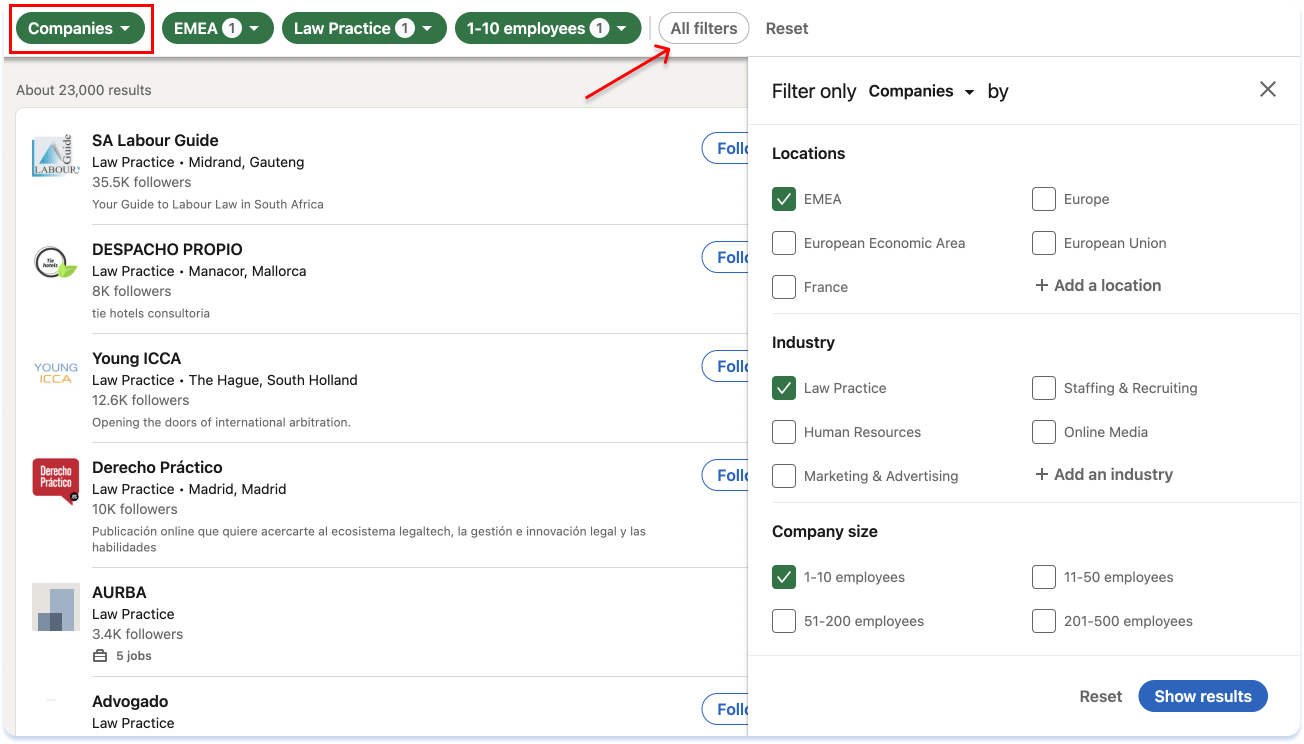
These can be used in conjunction with Boolean searches to narrow down your results. For instance:
(“Software Engineer” OR “Programmer”) AND “Startup” NOT “Manager”
When you apply an industry-specific filter such as ‘Information Technology and Services’, you further refine your search to target individuals within a specific sector, enhancing the relevance of your search results.
Search alerts to track relevant content writer profiles
LinkedIn allows you to set up search alerts for your Boolean queries, which can be incredibly useful for ongoing recruitment or sales efforts.
By setting an alert for the search string:
“Content Writer” AND “Marketing” NOT “Senior”
You’ll receive notifications when new profiles that meet your criteria appear on LinkedIn, enabling you to reach out promptly and potentially secure an ideal candidate or lead before the competition.
Employing these Boolean techniques will streamline your LinkedIn search process, making it faster and more effective. By understanding the nuances of job titles, leveraging additional filters, and utilizing search alerts, you can ensure that your professional networking on LinkedIn is as productive as possible.
Explore search dynamics and algorithms on LinkedIn
Understanding how LinkedIn’s search dynamics and algorithms work can give you a significant edge in executing Boolean searches.
The platform’s algorithm can affect search outcomes, and being aware of operator limitations and premium account capabilities can further refine your search strategy.
LinkedIn algorithm behavior that affects Boolean search outcomes
LinkedIn’s search algorithm is complex and takes into account various factors such as profile completeness, network connections, and engagement levels.
If you want some advice to make the LinkedIn algorithm love you, follow this tip! ⬇️
When conducting a Boolean search, these factors can influence the ranking of your search results. It’s important to consider:
(“Digital Marketing Specialist” OR “SEO Expert”) AND “Engagement” NOT “Intern”
This string might prioritize profiles with higher engagement on LinkedIn, such as regular content sharing or networking activity, as they are more likely to appear in search results.
Address operator limitations and compensating strategies
While Boolean search is powerful, it’s not without its limitations on LinkedIn. For example, LinkedIn limits the complexity of Boolean strings and the number of operators you can use.
To compensate, you can:
(“Sales Manager” OR “Business Development Manager”) AND “SaaS” AND “B2B” NOT “Director”
Break down your search into simpler queries and conduct multiple searches instead of one overly complex string. This approach allows you to manage the limitations and still cover a broad scope of profiles.
Additional search capabilities for LinkedIn sales marketing manager
Premium LinkedIn accounts, such as Sales Navigator, offer advanced search capabilities that go beyond standard Boolean searches.
Sales and marketing managers can benefit from additional filters, more detailed search insights, and increased search limits. For instance:
“Sales Manager” AND (“Enterprise” OR “Strategic”) AND “Account Management” NOT “Entry-Level”
With a premium account, you can refine this search with exclusive filters like company headcount growth rate or functions, enabling a more targeted approach to finding the right profiles.
By mastering LinkedIn’s search algorithm, addressing the limitations of Boolean operators, and exploiting the capabilities of premium accounts, you can significantly optimize your LinkedIn Boolean search strategies for better, more relevant results.
Boolean strategies for customized LinkedIn tools
Customized LinkedIn tools like LinkedIn Recruiter and Sales Navigator are designed to enhance the Boolean search experience.
By employing proficient Boolean strategies within these tools, professionals can fine-tune their search for people, optimize lead generation, and tailor job-seeking efforts with greater precision.
Advanced search operations within LinkedIn Recruiter
LinkedIn Recruiter is a powerful tool for talent acquisition professionals that offers advanced search operations. To leverage its full potential, one must understand how to construct complex Boolean search strings effectively. For example:
(“Project Manager” OR “Program Manager”) AND “PMP” NOT “Entry-Level”
This search string can help recruiters find experienced project management professionals who have a PMP certification while excluding those who are at the entry level. LinkedIn Recruiter’s interface allows for the seamless integration of these strings into the search bar, providing a streamlined process for finding the right candidates.
Customize Sales Navigator with Boolean search to optimize lead generation
Sales Navigator is tailored for sales professionals seeking to generate leads. By customizing the tool with Boolean search, sales teams can significantly enhance their prospecting efforts.
Consider this search string:
“VP” OR “Director” AND “Marketing” AND “Software” NOT “Freelancer”
This string is designed to target high-level marketing executives in the software industry, excluding freelancers. Sales Navigator’s advanced filters can then be applied to narrow down the search to specific regions, industries, or company sizes, making the lead generation process more efficient and effective.
Boolean search for job seekers on LinkedIn’s main platform
Job seekers on LinkedIn can also use Boolean search to discover opportunities that match their skills and experience. A strategic approach to constructing search strings can greatly improve the visibility of relevant job postings. For instance:
“Software Engineer” AND (“Startup” OR “Tech Company”) NOT “Senior”
This string helps job seekers find software engineering roles within startups or tech companies, while excluding senior-level positions that may be beyond their current experience. By using Boolean search on LinkedIn’s main platform, job seekers can tailor their job hunt and increase their chances of finding the right fit.
Whether you’re recruiting top talent, seeking out new business leads, or hunting for your next career move, mastering Boolean search within LinkedIn’s customized tools can give you a competitive edge. By understanding and applying these strategies, you can conduct highly targeted searches that yield precise and valuable results.
Key Takeaways
The strategic use of Boolean operators can significantly enhance the precision and efficiency of your search efforts, whether you’re seeking job opportunities, recruiting talent, or building professional relationships.
The key to success with LinkedIn Boolean search lies in understanding and applying the basic and advanced operators—AND, OR, NOT, quotation marks, and parentheses—to construct search strings that yield targeted results.
Don’t forget practice makes perfect. By trying out different combinations of operators and keywords, you can refine your search strategies. Don’t be afraid to learn from trial and error; each search is an opportunity to fine-tune your approach and become more adept at finding the right connections and opportunities.
Your source of actionable outreach tips and strategies that will help you get replies and grow your business.

